Large Scale Mining
Cue Resources Seeks Uranium in Paraguay
March 2011 by Leonard Melman
When it comes to South American countries on the mining development map, one of the least known is Paraguay, and yet it is within that country, one of only two land-locked nations on the continent, that Vancouver-based Cue Resources Ltd. is working diligently to develop their uranium project. Several factors combine to add special interest to Cue’s property including a remarkable history, recent developments within the field of projected demand for nuclear power, plus Paraguay’s own efforts to make the country more attractive to mining ventures.It was most interesting to visit Cue’s Yuty Project personally in early February, accompanied by company president Bob Tyson and project manager Tim Marlowe.
Paraguay itself is located near the center of South America, some distance removed from both the Pacific and Atlantic oceans, but it possesses two vitally important assets that minimize any disadvantage caused by their geography—two huge rivers, the Paraná and the Paraguay. These waterways provide access to Uruguayan and Argentinean deep-water ports on the Atlantic. The capital city of Asunción, a metropolis of approximately 1,300,000 inhabitants, is located on the Paraguay River and provides an array of supporting equipment, personnel and supplies for mining operations.
Paraguay’s first mining activity was initiated by Jesuit priests when they found gold while active in the region populated by the Guaraní tribes during the 18th century. Sporadic mining activities continued until the middle of the 19th century when the great war of 1865 (the War of the Triple Alliance) took place, wiping out most of the male population and leaving Paraguay as a sadly weakened nation.
Some mining activity resumed in the 1920s and then took a leap forward when Anschutz Corporation began developing the eastern half of Paraguay in the 1970s.
Beginning in 1955, the country was ruled as a dictatorship under Alfredo Stroessner, and during that time the country acquired a somewhat negative reputation in terms of openness to business and government corruption. However, Stroessner was overthrown in a 1989 coup, and in 2008 a breath of fresh air began to invigorate the country in the form of a new president leading a new administration committed to opening the country to development. An example of Paraguay’s new attractiveness is Rio Tinto’s plans to build a $3.5 billion aluminum refinery along the Paraná River.
Among the supportive measures for mining now in place is a simplified mining law and a growing background of geological information provided by the government.
Cue Resource’s Yuty Uranium Project is located adjacent to the town of the same name, some 120 miles (200 km) by air east and southeast of Asunción and approximately 160 miles by paved road, except for the last 50 miles, which is improved gravel/dirt. Heavy equipment and supplies are brought in by truck, a drive of some 4.5 to 5.0 hours from the capital city, and an airstrip provides for fixed wing aircraft access. The area terrain is approximately 400 feet (125 meters) above sea level and is relatively flat. Yuty’s climate allows for year-round operations, subject to stoppage only due to occasional, very heavy tropical rainfalls.
Cue owns 100% of the Yuty project, which itself is divided into four concessions covering an immense area of 584,775 acres (236,650 hectares)!
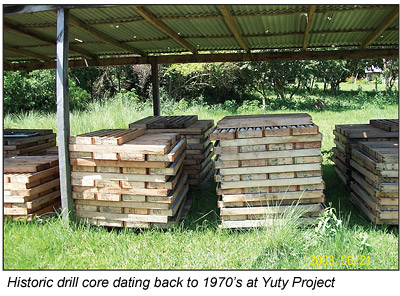 Uranium exploration history at Yuty goes back to 1976, when Anschutz Corporation obtained a concession from the government to explore the region for “all minerals, excluding oil, gas and construction materials.” The area had seen limited production of high grade iron ore along with sand and gravel by indigenous peoples. Anschutz, along with joint venture partners Korea Electric Power Corporation and Taiwan Power Corporation, originally performed 246,000 feet of core and rotary drilling between 1976 and 1983, intersecting uranium mineralization in drill holes ranging from 0.115% U3O8 over 33.5 feet (10.2 meters) to 0.351% U3O8 over 1 foot (0.3 meters) with such mineralization occurring in sandstones and siltstones.
Uranium exploration history at Yuty goes back to 1976, when Anschutz Corporation obtained a concession from the government to explore the region for “all minerals, excluding oil, gas and construction materials.” The area had seen limited production of high grade iron ore along with sand and gravel by indigenous peoples. Anschutz, along with joint venture partners Korea Electric Power Corporation and Taiwan Power Corporation, originally performed 246,000 feet of core and rotary drilling between 1976 and 1983, intersecting uranium mineralization in drill holes ranging from 0.115% U3O8 over 33.5 feet (10.2 meters) to 0.351% U3O8 over 1 foot (0.3 meters) with such mineralization occurring in sandstones and siltstones.Other work by Anschutz included airborne radiometric surveys, regional geologic mapping and geochemical sampling. However, after spending approximately $30 million, all work was suspended in 1983 with the collapse of uranium prices and demand.
All the information obtained by the Anschutz J.V. was then held by the Paraguayan government until Cue, working through its subsidiary Transandes Paraguay S.A., acquired an initial 30% interest in the Yuty Concessions in 2006, later enlarged to 100% in 2008 upon the fulfillment of earn-in requirements. Title to the concessions is held through a 20-year “Concession Contract” with the Republic of Paraguay, which allows for both exploration and exploitation. The contract is extendable in five-year increments after the initial twenty years.
Geologically, the Yuty project area is located within the Paraná Basin and is underlain mainly by sedimentary rocks of undivided Permo-Carboniferous Age. Occasional diabase sills and dikes intrude the sedimentary rocks. The Paraná Basin is host to a number of known uranium deposits, including Figueira and Amorinopolis in Brazil, and the San Antonio deposit on the Yuty Concession.
Since beginning work at Yuty in 2006, Cue has focused on acquiring and reviewing all data from the Anschutz period, including lithologic and radiometric logs that had been stored at the Ministry of Public Works in Asunción.
This was followed by the development of their own systematic uranium exploration program, including over 91,800 feet (28,000 meters) of diamond and rotary drilling in 223 holes.
As a result of these combined efforts, a NI 43-101 compliant “Technical Report on the Yuty Uranium Project” was published in 2009 that identified an Indicated Resource totaling 9.0 million metric tonnes at an average grade of 0.042% eU3O8 for a total of 8.3 million lbs. contained eU3O8 plus an Inferred Resource totaling 1.1 million tonnes grading 0.050% eU3O8 for a total of 1.2 million lbs. of eU3O8. These resource estimates were 77% larger than those reported in an earlier 2008 compliant report.
The above resources are located at San Antonio, but 64 historic holes had also been drilled at the San Miguel area, located just to the north of San Antonio. Three of those holes returned values in the 0.10 to 0.50% eU3O8 range, multiple mineralized zones were identified and the company plans to include San Miguel in its drilling plans for 2011. However, the primary focus remains San Antonio, which is the most advanced project area.
Following on the 2009 Technical Report, Cue initiated a new 30-hole drilling program at San Antonio in November, 2010, with the goal of defining additional resources and also increasing knowledge of the hydrological parameters of the San Antonio aquifer. The latter subject is of great importance to Cue since their projected production plans call for “in-situ recovery” processes and a clear understanding of hydrological conditions is vital to optimizing that process.
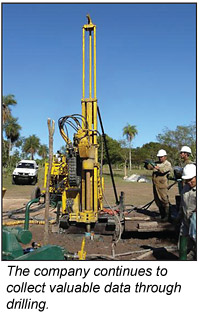
Going forward into 2011, the company’s plans include the initiation of an additional 30-hole drill program covering about 11,500 feet (3,500 meters) from February through April at a budget of $1,000,000 plus an additional $300,000 allowed for pump testing and leach testing. Another drill program is scheduled for summer 2011, moving toward the goal of increasing the known resource to at least 15 million pounds U3O8. If otherwise justified, a feasibility study may then be commissioned to advance the project toward production.
Cue has made considerable efforts to work with the local community and has received a generally positive response. Local residents own an area camp, capable of housing 32 workers, plus kitchen and dining facilities, which Cue has now successfully contracted for the housing of drill and project workers. Area landowners have permitted drilling on their properties for a fee and, during our tour, company President Bob Tyson and Project Manager Tim Marlowe met with local community leaders, including Yuty Mayor Nelson Vera and Peace Corps worker Marcia Mundt. They indicated their enthusiastic support for the developing project, acknowledging it could provide a needed economic infusion as well as becoming the source of valuable training for the area’s indigenous peoples.
Modern technology has been of great assistance in the company’s exploration work in two particular forms. In the first case, recently developed pump-testing equipment allows company geologists to measure the rate at which a mixture of water, low-grade sulphuric acid and uranium will flow through the sandstone material during the projected in-situ recovery (ISR) mining process. ISR would involve driving water and low-grade sulphuric acid down into the ore body, forcing the resultant fluid (lixiviant) up to the surface via a submersible pump; passing the mixture through recovery wells; followed by pumping into an elution and precipitation circuit before passing through a yellowcake dryer to produce the final product.
In the second case, Cue has been able to utilize a “down hole gamma logger” whereby geologists are able to lower the instrument into drill holes and it records the locations and strength of radiation indicator returns.
Cue’s recent development of the Yuty Project has coincided with growing strength in the general uranium market. The price for fuel-grade uranium has risen to above $70 per pound for the first time in several years and a lengthy list of countries have now reported specific plans for increasing the number of nuclear power reactors into the future.
According to data released by the World Nuclear Association, in addition to 443 reactors already in operation, 62 new ones are under actual construction, 158 are already in the planning stages and an additional 322 new reactors have been proposed. These activities involve almost fifty different nations and “under construction” and “proposed” new projects will more than double the amount of electricity generated from nuclear sources.
Even the previously-hostile environmental movement is now a frequent supporter of nuclear power, given that it is pollution-free and provides a sound alternative to relatively high-polluting coal-fired power plants.
_______________
Further information is available on the web at www.cue-resources.com or by email at info@cue-resources.com
The Wild Rush To Find More Cobalt—Part II
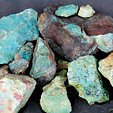 In this second part on cobalt, I will take a look at the various types of cobalt deposits and how you can prospect for them. Who knows—perhaps the next big cobalt strike will be yours.
In this second part on cobalt, I will take a look at the various types of cobalt deposits and how you can prospect for them. Who knows—perhaps the next big cobalt strike will be yours.
The Coeur Rochester Mine
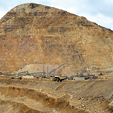 One of the reasons I am bringing this article forward to readers now is that the mine personnel are celebrating the production of 150 million ounces of silver since 1986.
One of the reasons I am bringing this article forward to readers now is that the mine personnel are celebrating the production of 150 million ounces of silver since 1986.
Iron Ores and Iron Mining
For more than 40 years, iron ore prices have been decided by private negotiations conducted between the largest of the iron miners and the largest steel producers. These two sides dominate both the spot and contract iron ore markets.
USFS OKs Exploratory Drilling in Eastern Idaho
The new plan approved by the FS says water for drilling at Dog Bone Ridge will now come from Beaver Creek rather than Coral Creek. The agency also said Excellon has added several monitoring sites associated with Dog Bone Ridge.
Thieves Make Off with Tons of Gold & Silver Ore
According to local press reports, about ten armed thieves forced their way into a private freight dispatch yard near the port, subdued employees, and then took several hours to search for the shipping containers…
Large Gold Deposit Types
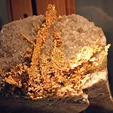 It is not necessary to have a PhD in geology, but you need to know the basics, so that’s what I am going to try to dig into here—the understandable basics of these gigantic gold deposits.
It is not necessary to have a PhD in geology, but you need to know the basics, so that’s what I am going to try to dig into here—the understandable basics of these gigantic gold deposits.
How to Refine Silver—Pt II
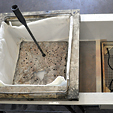 Silver recovery from low-level solutions is frequently done in a cell that has a cathode with 2 to 5 or more times the surface area as the anode.
Silver recovery from low-level solutions is frequently done in a cell that has a cathode with 2 to 5 or more times the surface area as the anode.
Subscription Required:
The Bawl Mill
• So You Want To Be A Full-Time Prospector?
• Ask The Experts—Do I still have rights to this mining claim?
• Ask The Experts—What is a "closed" claim?
• Eastern Arizona: Gold and Base Metal Deposits Part II
• Rediscovering Placerville, California Part II
• Prospecting With The Help of Fluvial Geomorphology
• Oregon Anti-Dredging Bill
• Mud Men: Pocket Miners of Southwest Oregon Part II
• The Gold of Plumas de Oro
• Melman on Gold & Silver
• Mining Stock Quotes and Mineral & Metal Prices
Free:
2011 Gold Prospecting & Mining Summit April 23-25 in Placerville
• Legislative and Regulatory Update








